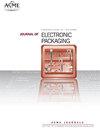星载光纤陀螺高温稳定性两阶段温度控制策略的数值研究
IF 2.3
4区 工程技术
Q3 ENGINEERING, ELECTRICAL & ELECTRONIC
引用次数: 0
摘要
光纤陀螺以其优越的空间适应性被广泛应用于卫星、火星车等航天器的姿态控制系统中。然而,环境温度的变化可能会导致FOG中的误差,并降低其输出精度。本文提出了一种应用于星载三轴集成光纤陀螺的模糊两阶段温度控制策略。并详细介绍了模糊两级温度控制器的控制规则。基于集总法,建立了一个能够快速、准确地响应星载TAIFOG动态热特性的热力学模型。通过数值研究验证了所提出的模糊两阶段温度控制策略在提高星载TAIFOG在轨温度稳定性方面的有效性。数值结果表明,该模糊两级主动温度控制策略可以从根本上改善星载TAIFOG的热状态,确保其敏感元件光纤线圈在TAIFOG在轨时保持高温稳定性。此外,与没有主动温度控制的情况相比,TAIFOG的启动时间减少到308秒,减少了96.27%。这种主动温度控制策略非常适合工程应用,以提高FOG输出精度。本文章由计算机程序翻译,如有差异,请以英文原文为准。
Numerical Study of Two-Stage Temperature Control Strategy for High Temperature Stability of Satellite-Borne Fiber Optic Gyroscope
Fiber optic gyroscopes (FOGs) are widely used in attitude control systems of spacecraft such as satellites and Mars rovers for their superior spatial adaptability. However, changes in ambient temperature can cause errors in the FOG and reduce its output accuracy. In this paper, a fuzzy two-stage temperature control strategy applied to a satellite-borne three-axis integrated fiber optic gyroscope (TAIFOG) is proposed. And the control rules of the fuzzy two-stage temperature controller are described in detail. A thermodynamic model that can quickly and accurately respond to the dynamic thermal characteristics of the satellite-borne TAIFOG is also constructed based on the lumped method. The effectiveness of the proposed fuzzy two-stage temperature control strategy in improving the temperature stability of the satellite-borne TAIFOG in orbit is verified through numerical studies. Numerical results show that this fuzzy two-stage active temperature control strategy can fundamentally improve the thermal state of the satellite-borne TAIFOG and ensure that its sensitive element fiber optic coils maintain high temperature stability while the TAIFOG is in orbit. In addition, the start-up time of TAIFOG is reduced to 308 seconds compared to the case without active temperature control, which is a reduction of 96.27%. This active temperature control strategy is well suited for engineering applications to improve FOG output accuracy.
求助全文
通过发布文献求助,成功后即可免费获取论文全文。
去求助
来源期刊

Journal of Electronic Packaging
工程技术-工程:电子与电气
CiteScore
4.90
自引率
6.20%
发文量
44
审稿时长
3 months
期刊介绍:
The Journal of Electronic Packaging publishes papers that use experimental and theoretical (analytical and computer-aided) methods, approaches, and techniques to address and solve various mechanical, materials, and reliability problems encountered in the analysis, design, manufacturing, testing, and operation of electronic and photonics components, devices, and systems.
Scope: Microsystems packaging; Systems integration; Flexible electronics; Materials with nano structures and in general small scale systems.
 求助内容:
求助内容: 应助结果提醒方式:
应助结果提醒方式:


